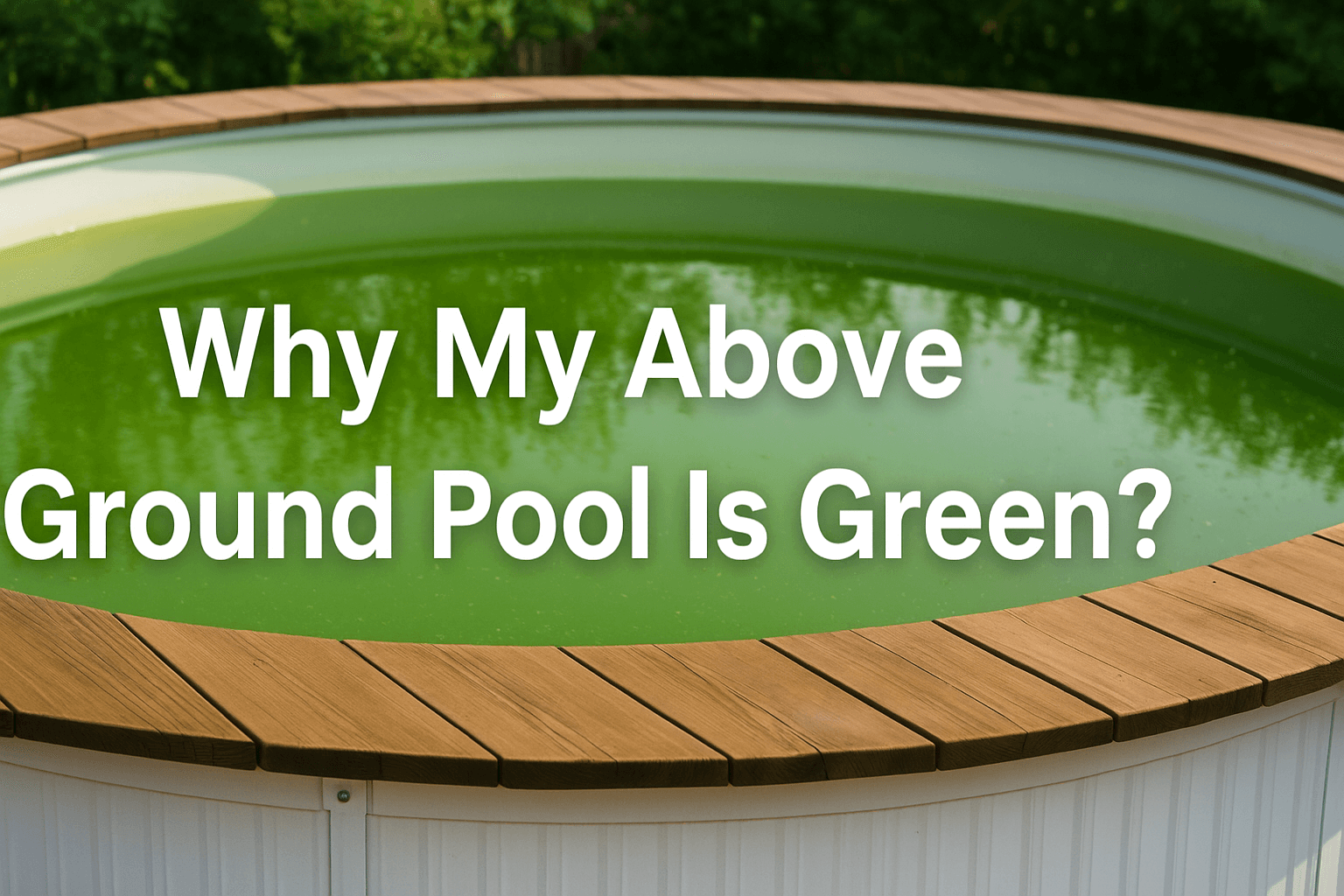
Why My Above Ground Pool Is Green?
Peek out at your garden pool and see swamp vibes? Short answer: algae’s moved in, thanks to dodgy chemicals, lazy filters, or wild weather. Stick around—I'll show you how to kick the green, keep it sparkling, and stop nature turning it into Frog Hotel.
My Above Ground Pool Is Green: Identifying the Cause
The Primary Culprit: Algae Overgrowth
Understanding How Algae Blooms Start
If your pool water’s taken on a greenish glow, chances are algae have set up camp. They love warmth, sunshine, and nutrients — a bit like us on a summer holiday, except they’re far less welcome.
Left unchecked, they multiply fast. Before you know it, your clear blue water looks like something from a fishing pond.
Common Triggers (Low Chlorine, High Phosphates, Warm Weather, Heavy Rain)
Algae don’t just appear out of nowhere. They thrive when chlorine levels drop, phosphates creep up, or pH swings out of balance.
Warm spells accelerate the problem. A heavy downpour can also wash extra nutrients into the water, giving algae the perfect growth boost.

Other Chemical and Filtration Issues
Imbalanced Water Chemistry (Incorrect pH and Alkalinity)
Getting the pH and alkalinity wrong is like inviting algae in for tea. Too high or too low, and chlorine can’t do its job properly.
Regular testing with a decent kit is your first line of defence.
Poor Water Circulation or a Clogged Filter
Think of your filter as the pool’s lungs. If it’s clogged, the water can’t “breathe” properly.
Debris builds up, algae get cosy, and water clarity suffers fast.
Not Running the Pool Pump Long Enough
Cutting pump run times might save on electricity, but it’s a false economy. Without enough circulation, dirt and algae hang around.
Most above ground pools do best with 8–12 hours of pump time during summer.
Non-Algae Causes of Green Water
Pollen Contamination (A Cloudy, Yellow-Green Tint)
Sometimes it’s not algae at all. Pollen from nearby trees can give your water a greenish haze — especially in spring.
The giveaway? It often settles on the surface before sinking.
Metal Oxidation (e.g., Copper from Pool Components)
Copper and other metals in pool parts or pipes can oxidise, tinting water green.
This is more common in older systems or when certain chemicals react with metal fixtures.
How to Fix a Green Above Ground Pool Fast
The Step-by-Step "Shock and Clear" Process
Step 1: Manually Brush the Walls and Floor
Grab a sturdy pool brush and give every inch of the walls and floor a scrub. This breaks up algae and stops it clinging.
Think of it as evicting squatters before you change the locks.
Step 2: Thoroughly Clean or Backwash the Filter
Your filter will have caught a lot of the mess. Clean it out or backwash it so it’s working at full power again.
A clean filter means faster recovery.
Step 3: Test and Balance pH and Alkalinity
Before you shock the pool, make sure the water chemistry’s in the right range.
If pH is too high or low, the chlorine won’t work properly — like trying to wash clothes with no detergent.
Step 4: Add a High-Dose Chlorine Shock Treatment
Go big with chlorine to wipe out the algae. Products like Clorox or Shockwave are reliable options.
Follow the instructions on the packet, and don’t swim until chlorine levels are safe again.
Step 5: Run the Filter Continuously for 24–48 Hours
This is where patience pays off. Let the filter run non-stop for a day or two to remove dead algae.
The water will clear steadily as the hours pass.
Step 6: Vacuum Dead Algae from the Pool Bottom
Once the algae have been killed and filtered, you’ll likely have a layer of gunk at the bottom.
Vacuum it away for that final, satisfying “ta-da” moment.

Troubleshooting a Pool That Stays Green
When to Use Algaecide and Other Specialty Chemicals
If you’ve shocked and brushed but the water still looks murky, it’s time for a targeted approach.
Algaecide can finish the job by wiping out stragglers.
Checking for Chlorine-Resistant Algae
Some algae — like mustard yellow or stubborn black — laugh in the face of standard chlorine doses.
They need specialised treatments, often with stronger chemicals or a double-dose shock.
The Need for an Intermediate Filter Clean or Replacement
If your filter’s old, damaged, or just not performing, a mid-treatment clean or swap could be the game-changer.
A struggling filter will slow down the whole process.
Preventing Your Above Ground Pool from Turning Green Again
Establishing a Consistent Maintenance Routine
Regular Water Testing and Chemical Balancing
Make water testing part of your weekly ritual. Check chlorine, pH, and alkalinity to stop algae in their tracks.
Small tweaks now save big headaches later.
Brushing and Vacuuming at Least Once a Week
A quick brush keeps surfaces slippery for algae — in a bad way. Vacuuming removes any debris before it can decompose and feed growth.
Skimming Debris from the Surface Daily
Leaves, bugs, and dirt are algae’s buffet. Scoop them out every day to keep the menu closed.

Optimising Your Filtration System
Ensuring the Pump Runs for a Sufficient Number of Hours
In summer, aim for 8–12 hours daily. In cooler months, you can ease off.
Good circulation keeps chemicals evenly distributed and water fresh.
Regularly Cleaning the Filter (Cartridge or Backwashing Sand)
A dirty filter is a weak link. Clean it often to keep everything running smoothly.
Using Algae-Fighting Tools and Techniques
Implementing a Weekly Shock Treatment
Even a small shock dose each week can keep algae from gaining ground.
Using an Algaecide as a Preventative Measure
Add algaecide regularly — it’s like insurance against an algae outbreak.
Utilising a Pool Cover to Block Sunlight and Debris
A cover isn’t just for winter. Use it to shield water from sunlight and keep out debris that feeds algae.
Have you checked out our other posts?
What To Do When Above Ground Pool Is Green?
Will Above Ground Pool Settle?
Above Ground Pool Is Not Level?


Leave a comment